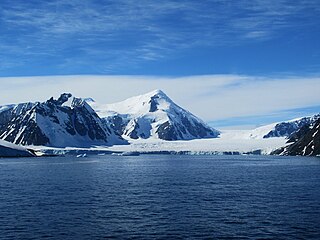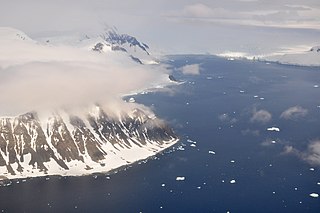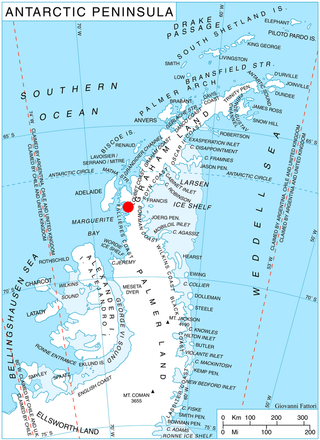Related Research Articles

Signy Island is a small subantarctic island in the South Orkney Islands of Antarctica. It was named by the Norwegian whaler Petter Sørlle (1884–1933) after his wife, Signy Therese.

Aagaard Glacier, also known as Glaciar Alderete, is an 8-mile (13 km) long Antarctic glacier which lies close to the east of Gould Glacier and flows in a southerly direction into Mill Inlet, on the east coast of Graham Land. It was charted by the Falkland Islands Dependencies Survey (FIDS) and photographed from the air by the Ronne Antarctic Research Expedition during December 1947; it was named by the FIDS for Bjarne Aagaard, a Norwegian authority on Antarctic whaling and exploration.

Arrowsmith Peninsula is a cape about 40 miles (64 km) long on the west coast of Graham Land, west of Forel Glacier, Sharp Glacier and Lallemand Fjord, and northwest of Bourgeois Fjord, with Hanusse Bay lying to the northwest. It was surveyed by the Falkland Islands Dependencies Survey (FIDS) in 1955-58 and named for Edwin Porter Arrowsmith, Governor of the Falkland Islands.
Blaiklock Island is a high and rugged, irregular-shaped island 17 kilometres (9 nmi) long, lying between Bigourdan Fjord and Bourgeois Fjord. It is separated from Pourquoi Pas Island by The Narrows and from the west coast of Graham Land by Jones Channel. The feature was partially surveyed in 1936 by the British Graham Land Expedition under Rymill, at which time it was charted as a promontory. It was determined to be an island in 1949 by Kenneth V. Blaiklock, a Falkland Islands Dependencies Survey (FIDS) surveyor for whom it is named.
Attlee Glacier is a glacier 8 miles (13 km) long, which flows east-southeast from the plateau escarpment on the east side of Graham Land to the head of Cabinet Inlet to the north of Bevin Glacier.
Contact Peak is a prominent rock peak, 1,005 metres (3,300 ft) high, which is the southeasternmost peak on Pourquoi Pas Island, off the west coast of Graham Land. It was first sighted and roughly charted in 1909 by the French Antarctic Expedition under Jean-Baptiste Charcot. It was surveyed in 1936 by the British Graham Land Expedition and in 1948 by the Falkland Islands Dependencies Survey (FIDS). It was so named by FIDS because the peak marks the granite-volcanic contact in the cliffs which is visible at a considerable distance.

Swithinbank Glacier is a glacier on the west side of Hemimont Plateau flowing north to the southeast corner of Square Bay, in Graham Land. Mapped by Falkland Islands Dependencies Survey (FIDS) from surveys and air photos, 1946–59. Named by United Kingdom Antarctic Place-Names Committee (UK-APC) for Charles Swithinbank, British glaciologist, a participant in several British, New Zealand and American expeditions to Antarctica, 1949–62.

Dalgliesh Bay is a bay, 1 nautical mile (2 km) wide and indenting 3 nautical miles (6 km), lying between Lainez Point and Bongrain Point on the west side of Pourquoi Pas Island, off the west coast of Graham Land. It was first roughly surveyed in 1936 by the British Graham Land Expedition under John Rymill. It was resurveyed in 1948 by the Falkland Islands Dependencies Survey (FIDS) and named for David G. Dalgliesh, FIDS medical officer at Stonington Island in 1948–49, who accompanied the 1948 sledge survey party to this area. Stride Peak rises to 675 m at the head of Dalgliesh Bay.

The Stokes Peaks is a group of peaks rising to about 800 m between McCallum Pass and Sighing Peak on the north side of Wright Peninsula, Adelaide Island, Antarctica. They were photographed from the air by the Falkland Islands and Dependencies Aerial Survey Expedition (FIDASE), 1956–57, and surveyed by the British Antarctic Survey (BAS), in 1961–62. They were named by the United Kingdom Antarctic Place-Names Committee (UK-APC) in 1977 for Jeffrey C.A. Stokes, Falkland Islands Dependencies Survey (FIDS) assistant surveyor, Admiralty Bay, 1959–60, and Adelaide Island, 1960–61.
The Dorsey Mountains are a mountain range just east of Somigliana Glacier in the northern part of the Arrowsmith Peninsula in Graham Land. They were mapped by the Falkland Islands Dependencies Survey (FIDS) from surveys and air photos in 1956 to 1959 and named by the UK Antarctic Place-Names Committee (UK-APC) for Noah Ernest Dorsey, an American physicist.

Perutz Glacier is a glacier, 10 nautical miles (18 km) long and 2 nautical miles (3.7 km) wide, which flows west-northwest from Hemimont Plateau into Bourgeois Fjord, close east of Thomson Head, on the west coast of Graham Land, Antarctica. The mouth of the glacier was first surveyed in 1936 by the British Graham Land Expedition (BGLE) under Rymill. The entire glacier was surveyed in 1946-47 and 1948-49 by the Falkland Islands Dependencies Survey (FIDS), and named by them for Max F. Perutz of the Cavendish Laboratory, Cambridge, who has made important studies on the mechanism of glacier flow.
Fricker Glacier is a glacier, 10 nautical miles (19 km) long, which lies close north of Tindal Bluff and Monnier Point and flows in a northeasterly direction into the southwest side of Mill Inlet, on the east coast of Graham Land, Antarctica. It was charted by the Falkland Islands Dependencies Survey (FIDS) and photographed from the air by the Ronne Antarctic Research Expedition in 1947, and was named by the FIDS for Karl Fricker, a German Antarctic historian.
Green Glacier is a glacier on the east side of Graham Land, Antarctica, 15 nautical miles (28 km) long and 4 nautical miles (7 km) wide, flowing from the plateau northeast between Dugerjav Peak and Rugate Ridge, and then east into Vaughan Inlet next north of Pirne Peak and south of the terminus of Hektoria Glacier.
Mimas Peak is a sharp conspicuous peak, rising to about 1,000 metres (3,300 ft) west of the head of Saturn Glacier and 9 nautical miles (17 km) west of the Dione Nunataks in the southeast part of Alexander Island, Antarctica. It was first seen and photographed from the air by Lincoln Ellsworth on November 23, 1935, and mapped from these photos by W.L.G. Joerg. The peak was sighted from a distance in 1949 by the Falkland Islands Dependencies Survey (FIDS) and roughly positioned. It was named by the UK Antarctic Place-Names Committee for its association with nearby Saturn Glacier, Mimas being one of the satellites of the planet Saturn. The peak and surrounding area were first mapped in detail from air photos taken by the Ronne Antarctic Research Expedition 1947–48, by D. Searle of the FIDS in 1960. Note that some maps incorrectly attach the name to a subsidiary and smaller peak off the east flank of the mountain. The name is actually attached to the highest peak in the Herschel Heights range.
Mount Liotard is a mountain having a conspicuous ice-covered peak, 2,225 metres (7,300 ft) high, standing midway between Mount Gaudry and Mount Ditte in the south part of Adelaide Island, Antarctica. It was discovered and first surveyed by the Fourth French Antarctic Expedition in 1909. It was resurveyed in 1948 by the Falkland Islands Dependencies Survey (FIDS) and named by the UK Antarctic Place-Names Committee for Andre F. Liotard, a French observer with the FIDS in 1947–48 and the leader of the French Antarctic Expedition, 1949–51.
The Haslam Heights are a line of peaks trending north-northeast–south-southwest, rising to about 1,000 metres (3,300 ft) to the west of Vallot Glacier and Nye Glacier in Arrowsmith Peninsula, Graham Land, Antarctica. They were probably first seen by the French Antarctic Expedition, 1908–10 under Jean-Baptiste Charcot, which roughly charted the area in 1909. They were roughly mapped by the Falkland Islands Dependencies Survey (FIDS) in 1948, and named in 1985 by the UK Antarctic Place-Names Committee (UK-APC) after Rear Admiral Sir David W. Haslam, Hydrographer of the Navy, 1975–85.
Hunt Peak is a triangular rock peak, 610 metres (2,000 ft) high, marking the north side of the entrance to Stonehouse Bay on the east coast of Adelaide Island, Antarctica. It was discovered and first roughly surveyed in 1909 by the French Antarctic Expedition under Jean-Baptiste Charcot. It was resurveyed in 1948 by the Falkland Islands Dependencies Survey (FIDS), who named the point marked by this peak for Sergeant Kenneth D. Hunt, a mechanic for the expedition's Noorduyn Norseman airplane in 1950. Further survey in 1957–58 by the FIDS showed no definable point in the vicinity and the name was transferred to the peak.
The Tyndall Mountains are a group of mountains close south of Avsyuk Glacier in central Arrowsmith Peninsula, Graham Land. Photographed from the air by FIDASE, 1956–57. Mapped by Falkland Islands Dependencies Survey (FIDS) from surveys and air photos, 1948–59. Named by United Kingdom Antarctic Place-Names Committee (UK-APC) for John Tyndall (1820–93), Irish mountaineer and pioneer glaciologist, author of many works on glaciers and the physical properties of ice.

Thomson Head is a, headland rising to 915 m at the cola side of Bourgeois Fjord, between Perutz and Bader Glaciers, forming the north extremity of German Peninsula on Fallières Coast on the west side of Graham Land, Antarctica. First surveyed in 1936 by the British Graham Land Expedition (BGLE) under Rymill. Resurveyed in 1948-49 by the Falkland Islands Dependencies Survey (FIDS) and named for William H. Thomson, FIDS air pilot at Stonington Island in 1947.
Relay Hills is a group of low, ice-covered hills, mainly conical in shape, between Mount Edgell and Kinnear Mountains in western Antarctic Peninsula. First roughly surveyed from the ground by British Graham Land Expedition (BGLE), 1936–37. Photographed from the air by Ronne Antarctic Research Expedition (RARE), November 1947. Resurveyed by Falkland Islands Dependencies Survey (FIDS), November 1958. The name, applied by the United Kingdom Antarctic Place-Names Committee (UK-APC), arose because both the BGLE and the FIDS sledging parties had to relay their loads through this area to the head of Prospect Glacier.
References
- ↑ "Hoskins Peak". Geographic Names Information System . United States Geological Survey, United States Department of the Interior . Retrieved 2012-06-27.
![]() This article incorporates public domain material from "Hoskins Peak". Geographic Names Information System . United States Geological Survey.
This article incorporates public domain material from "Hoskins Peak". Geographic Names Information System . United States Geological Survey.